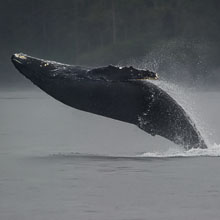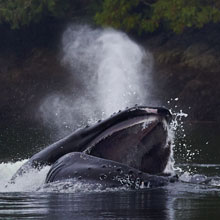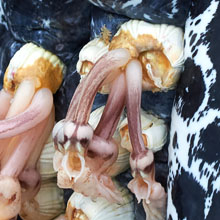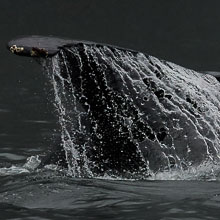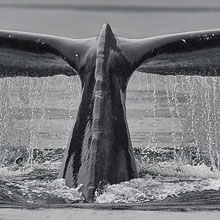Availability: Undetermined - Enquiries?
In the Field
It's Curtains for You! Waters of Great Bear Rainforest, BC, Canada. October 5, 2013.
When photographing whales from above the surface of the water, you have to accept that you're going to see your subjects for only about 10% or less of your total "contact" time with them and end up bearing witness to only a narrow portion of their total behavioural repertoire. When it comes to Humpback Whales, that means you generally have 3 categories of things to shoot - breaches (such as the graceful leap captured here), feeding (including bubble-netting and lunge feeding), and tail shots.
While it is almost impossible for a keen nature photographer NOT to photograph ANY whale tail you see (and usually while blazing away at the highest frame rate your camera can muster!), after looking at about 1000 or so of the tail shots I have in my collection I have come to this conclusion: if you're shooting in a place where whales are common, it is REALLY, REALLY easy to end up with a tons (literally) of quite boring tail shots! You know...stuff that the photographer likes, but quickly puts an audience to sleep!
When I critiqued my own whale tail collection, I noticed a few things that made some of the images interesting to me. First, in the right conditions the trailing edge of the tail can produce a very visually interesting "curtain" of water draining off the flukes - almost like a waterfall or cascading rapids. In most situations the curtain is quite incomplete and not too interesting, but once in a while you get a nearly complete curtain. Second, if the ambient light is just right (and usually this means overcast skies) the water on the surface of the whale reflects just the right amount of light to accentuate interesting textures in the skin. These reflections can lead to a high-contrast image that definitely grabs one's eye! And, last but not least, sometimes individual-specific anomalies on the whale's tail - everything from striking patterns and/or scars and even the presence of barnacles living on the edges of the flukes - can increase the visual interest of tail shot.
So...in the autumn of 2013 I went on my photo tour into the Great Bear Rainforest vowing to be more selective and discerning in my shooting of humpback tails. Was I successful? Well...partly. I still took about a billion shots of those pesky tails (they're just SO seductive and compelling to shoot!). BUT, I did pay particular attention to lighting and "curtain patterns" and ensured I didn't miss those opportunities. In the case of this shot it meant that recognizing that it was critical to losing NONE of the highlight details in the curtain of water streaming off the tail. Which meant a major under-exposure of the scene (relative to the matrix-metered "suggested" exposure) - here it was -1.0 stops. It also meant choosing a shutter speed that was pretty much guaranteed to "freeze" the streaming water (1/1250s). And, I now finally have a few humpback tail shots in my collection that are not quite as likely to bore viewers to death and perhaps just might qualify as "natural art" to some!
This one looks better in high resolution form - so here's a 2400 pixel version of it for you to view:
• It's Curtains for You! Download 2400 pixel image (JPEG: 1.7 MB)
ADDITIONAL NOTES:
NOTE 1: This image - in all resolutions - is protected by copyright. I'm fine with personal uses of it (including use as desktop backgrounds or screensavers on your own computer), but unauthorized commercial use of the image is prohibited by law. Thanks in advance for respecting my copyright!
NOTE 2: Like all wildlife photographs on this website, this image was captured following the strict ethical guidelines described in The Wildlife FIRST! Principles of Photographer Conduct. I encourage all wildlife photographers to always put the welfare of their subjects above the value of their photographs.
NOTE 3: This image was captured during one of my "Into the Great Bear Rainforest" photo tours in the autumn of 2013. Each year I offer trips into two different parts of the Great Bear Rainforest as well as one to photograph aquatic mammals and oceanscapes near the northern tip of Vancouver Island. And, in selected years, I also offer photo tours to locations to capture other highly sought-after subjects, such as various owl species of the boreal forest and wildlife of Canada's Arctic. Details about these trips can be found on the Photo Tours page of this website.
Behind the Camera
It's Curtains for You! Waters of Great Bear Rainforest, BC, Canada. October 5, 2013.
Digital Capture; Compressed RAW (NEF) 14-bit format; ISO 2200.
Nikon D4 with Nikkor 400mm f2.8G VR lens - hand-held from deck of sailboat. VR on in "Normal" mode.
1/1250s @ f6.3; -1.0 stop compensation from matrix-metered exposure setting.
At the Computer
It's Curtains for You! Waters of Great Bear Rainforest, BC, Canada. October 5, 2013.
RAW Conversion to 16-bit TIFF, including first-pass/capture sharpening using Phase One's Capture One Pro 7. Three exposure variants covering a 0.9 stop total range.
Further digital corrections on resulting 16-bit TIFF files using Adobe's Photoshop CS5 and Light Craft's Lightzone. Photoshop adjustments including compositing (layering and masking) the exposure variants using multiple luminosity masks, selective exposure and curves (contrast) adjustment using adjustment layers, and selective sharpening for web output. Final tone tweaking performed using the tonemapper tool in LightZone.
Conservation
It's Curtains for You! Waters of Great Bear Rainforest, BC, Canada. October 5, 2013.
Ten percent of the revenue generated by this image will be donated to Raincoast*.
Species Status in Canada**: Threatened - North Pacific population (May 2003).
Humpback Whales (Megaptera novaeagnliae) are active, acrobatic whales that can throw themselves completely clear of the water (a behaviour known as breaching) and will swim on their backs with both flippers in the air. Humpbacks are large (up to 14m - or 46 feet - in length and 40 tonnes in weight) and with huge flippers.
Humpbacks are found in tropical, temperate, and sub-polar waters around the world. They are found on both the east and west coasts of North America. The North Pacific population has been estimated at between 6,000 and 8,000 individuals, but only a few hundred of these are found in the waters off the coast of British Columbia.
While Humpbacks are recovering from the damage done to their populations by commercial fishing, the are still subject to a variety of threats from human activities, including becoming entangled in fishing nets, noise and chemical pollution and habitat destruction.
*The Raincoast Conservation Society (and Foundation) is an effective and efficient organization that has been fighting for protection of this unique habitat. If you are looking for a meaningful way to contribute to the conservation of this amazing ecosystem, Raincoast will provide maximal "bang" for your conservation dollars.
**as determined by COSEWIC: The Committee on the Status of Endangered Wildlife in Canada



















